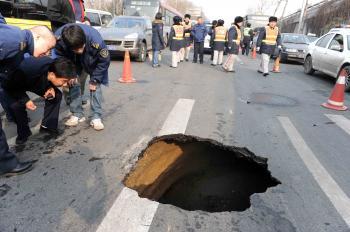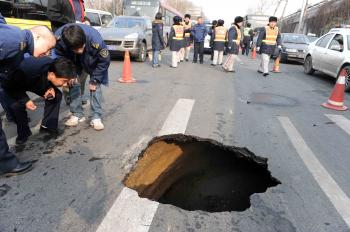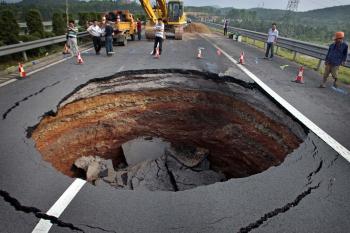While the Guatemalans are wondering if the giant sinkhole formed on June 1 in their capital city is an isolated case, on the other side of the globe, the Chinese have discovered at least eight sinkholes that suddenly formed in the past two weeks across their country, and many more have appeared during the past two months.
The latest known sinkhole formed at 12:25 a.m. Beijing time on June 4, in the middle of a freeway in Zhejiang Province on the nation’s eastern coast. The sinkhole measured 20 feet deep and 27 feet wide.
The latest known sinkhole formed at 12:25 a.m. Beijing time on June 4, in the middle of a freeway in Zhejiang Province on the nation’s eastern coast. The sinkhole measured 20 feet deep and 27 feet wide.
The hole occurred when a light truck drove over the spot. The truck rolled over when its rear wheels were caught at the edge of the hole. The slightly injured driver climbed out and stopped traffic when he saw the giant hole. Police arrived within 10 minutes and blocked the road.
A spokesperson for the local freeway management office said experts on site suspected that the sudden collapse of an underground karst cave created by eroded limestone caused the sinkhole, but the investigation is ongoing.
Later the same day, about 300 miles west in Nanchang City, capital Jiangxi Province, a moving car was trapped when a hole about the size of the car suddenly opened up on a main road.
On June 3, four huge sinkholes opened up in Guangxi Province where a torrential storm was raging. According to Chinese state media reports, more than 600 villagers had to be evacuated because of them.
Three smaller holes were found between May 27 and May 30 in southwestern Sichuan Province, less than 80 miles from the Wenchuan epicenter of the deadly May 2008 Sichuan earthquake that killed approximately 80,000 people.
In Yibin City about 260 miles from the earthquake’s epicenter, 26 larger sinkholes have formed since April 27.
The outbreak of sinkholes has struck fear in Chinese people. Though reports in official media always quote “experts” that conclude such holes are not warning signs of another major earthquake, people have little trust in such comments.
Online bloggers posted footage of similar alleged expert reassurances aired on local TV news channels shortly before the Sichuan earthquake. They are criticizing such assertions as no more than authorities’ tricks to maintain so-called social stability.
“What I hate most of the ‘experts’ on TV who confidently promise everything is OK,” wrote one blogger. “They’re saying this only because the government told them to.”
Many other bloggers joked that when the media start to refute earthquake rumors, it is time to pack up and leave because an earthquake is surely around the corner.
Having little trust in the regime’s official reports, Chinese are now increasingly wary of abnormalities such as the appearance of large herds of toads or snakes, or clouds of unusual colors or shapes, and pay serious attention to any disaster warnings on blog sites.
Sinking government credibility and all too fresh memories of a series of recent disasters are causing Chinese society to become easily agitated. This February, the mere rumor of an earthquake scared tens of thousands of citizens in Taiyuan City in Shanxi Province out of their homes and into the streets to spend the night.
A spokesperson for the local freeway management office said experts on site suspected that the sudden collapse of an underground karst cave created by eroded limestone caused the sinkhole, but the investigation is ongoing.
Later the same day, about 300 miles west in Nanchang City, capital Jiangxi Province, a moving car was trapped when a hole about the size of the car suddenly opened up on a main road.
On June 3, four huge sinkholes opened up in Guangxi Province where a torrential storm was raging. According to Chinese state media reports, more than 600 villagers had to be evacuated because of them.
Three smaller holes were found between May 27 and May 30 in southwestern Sichuan Province, less than 80 miles from the Wenchuan epicenter of the deadly May 2008 Sichuan earthquake that killed approximately 80,000 people.
In Yibin City about 260 miles from the earthquake’s epicenter, 26 larger sinkholes have formed since April 27.
Prelude to Disaster?
The outbreak of sinkholes has struck fear in Chinese people. Though reports in official media always quote “experts” that conclude such holes are not warning signs of another major earthquake, people have little trust in such comments.
Online bloggers posted footage of similar alleged expert reassurances aired on local TV news channels shortly before the Sichuan earthquake. They are criticizing such assertions as no more than authorities’ tricks to maintain so-called social stability.
“What I hate most of the ‘experts’ on TV who confidently promise everything is OK,” wrote one blogger. “They’re saying this only because the government told them to.”
Many other bloggers joked that when the media start to refute earthquake rumors, it is time to pack up and leave because an earthquake is surely around the corner.
Having little trust in the regime’s official reports, Chinese are now increasingly wary of abnormalities such as the appearance of large herds of toads or snakes, or clouds of unusual colors or shapes, and pay serious attention to any disaster warnings on blog sites.
Sinking government credibility and all too fresh memories of a series of recent disasters are causing Chinese society to become easily agitated. This February, the mere rumor of an earthquake scared tens of thousands of citizens in Taiyuan City in Shanxi Province out of their homes and into the streets to spend the night.






